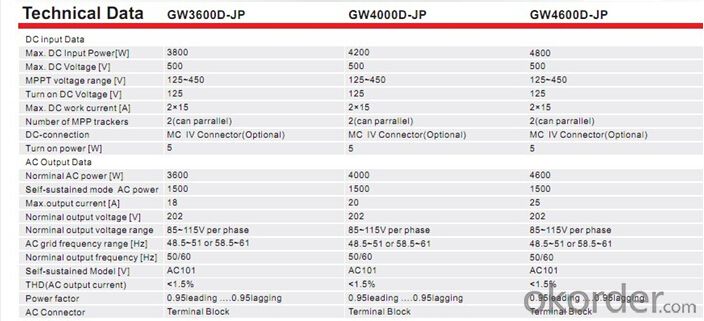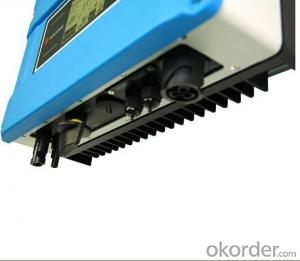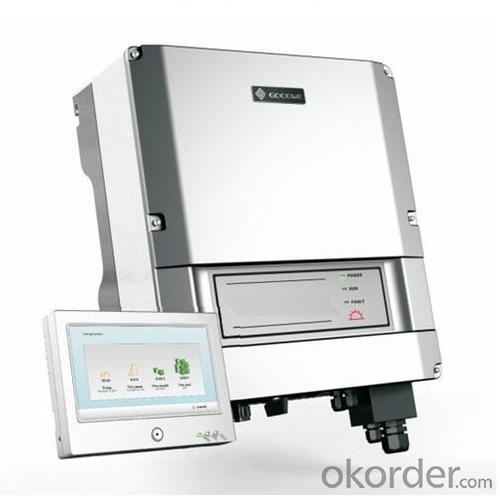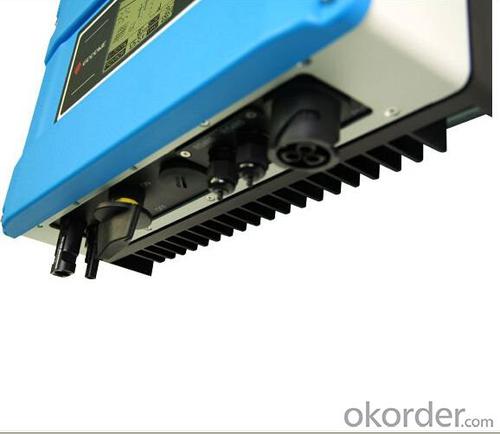IGBT On Grid Solar Inverter GW3000D-JP
OKorder Service Pledge
OKorder Financial Service
You Might Also Like
GW3000D-JP
JP Series Inverter is suitable to the domestic applications, and designed under modern ID concept, it has created a new standard for inverter technology with more advanced reactive compensation technology and dual MPPT trackers. Not only be able to connect with two phase grid system, this model but also could run as off-grid model, and the wide range of frequency of 50/60Hz makes it a good choice for Japan market. Moreover, the specialized monitor could perfectly control the inverter operation and data logging. IP65 high protective class of housing ensures the inverter work persistently and steadily under all critical environment.
Datasheet

- Q: Can a solar inverter be connected to the grid?
- Yes, a solar inverter can be connected to the grid. In fact, grid-connected solar inverters are designed to convert the direct current (DC) generated by solar panels into alternating current (AC) that can be fed back into the electrical grid. This allows excess electricity produced by the solar panels to be distributed and used by other consumers, and in some cases, even earn credits or financial compensation through net metering.
- Q: Is the grid side of the grid and the inverter?
- Grid-type system power transmission sequence: photovoltaic panels> relays> inverters> relays> electricity load + power grid (both in parallel).
- Q: What is the role of a solar inverter in a solar-powered ventilation system?
- The role of a solar inverter in a solar-powered ventilation system is to convert the direct current (DC) generated by solar panels into alternating current (AC) that can be used to power the ventilation system. It ensures that the electricity generated by the solar panels is compatible with the system's requirements and can efficiently operate the ventilation components.
- Q: How does the voltage regulation affect the performance of a solar inverter?
- Voltage regulation is crucial for the optimal performance of a solar inverter. It ensures that the output voltage of the inverter remains within a specific range, typically the utility grid's voltage standards. Proper voltage regulation prevents overloading or underloading of the electrical devices connected to the inverter, safeguarding them from potential damage. Additionally, maintaining a stable output voltage enhances the efficiency and reliability of the solar inverter, allowing it to deliver consistent power to the connected load and maximize the overall system performance.
- Q: What is the lifespan of the capacitors in a solar inverter?
- The lifespan of capacitors in a solar inverter can vary depending on several factors such as the quality of the capacitors used, operating conditions, and maintenance. However, on average, capacitors in a solar inverter can have a lifespan of around 10 to 15 years.
- Q: Can a solar inverter be used in commercial applications?
- Yes, a solar inverter can be used in commercial applications. Commercial buildings can install solar panels and connect them to a solar inverter, which converts the DC power generated by the panels into usable AC power for the building's electrical system. This allows commercial establishments to harness solar energy and reduce their reliance on traditional grid power sources, resulting in cost savings and environmental benefits.
- Q: How do you calculate the power loss in a solar inverter?
- To calculate the power loss in a solar inverter, you need to determine the difference between the input power and the output power. Subtracting the output power from the input power will give you the power loss.
- Q: Can a solar inverter be used with solar-powered water purification systems?
- Yes, a solar inverter can be used with solar-powered water purification systems. A solar inverter is responsible for converting the direct current (DC) produced by solar panels into alternating current (AC) that can be used to power electrical devices. In the case of solar-powered water purification systems, the solar panels generate electricity through sunlight, which is then converted by the solar inverter to power the purification system, ensuring clean and safe drinking water.
- Q: How does a solar inverter affect the overall system reliability?
- A solar inverter plays a crucial role in enhancing the overall system reliability of a solar power system. It converts the direct current (DC) generated by solar panels into alternating current (AC) that can be used to power household appliances and feed excess energy into the grid. By efficiently managing and controlling the flow of electricity, a reliable solar inverter ensures smooth operation of the entire system, preventing power fluctuations, voltage surges, and other electrical issues. Additionally, advanced features like anti-islanding protection and monitoring capabilities enable early detection and prevention of potential faults, further enhancing the system's reliability and performance.
- Q: What is the role of a solar inverter in a solar-powered desalination system?
- The role of a solar inverter in a solar-powered desalination system is to convert the direct current (DC) electricity generated by the solar panels into alternating current (AC) electricity that can be used to power the desalination process. The inverter ensures that the energy produced by the solar panels is compatible with the desalination system, allowing it to operate efficiently and effectively.
Send your message to us
IGBT On Grid Solar Inverter GW3000D-JP
OKorder Service Pledge
OKorder Financial Service
Similar products
Hot products
Hot Searches
Related keywords
























